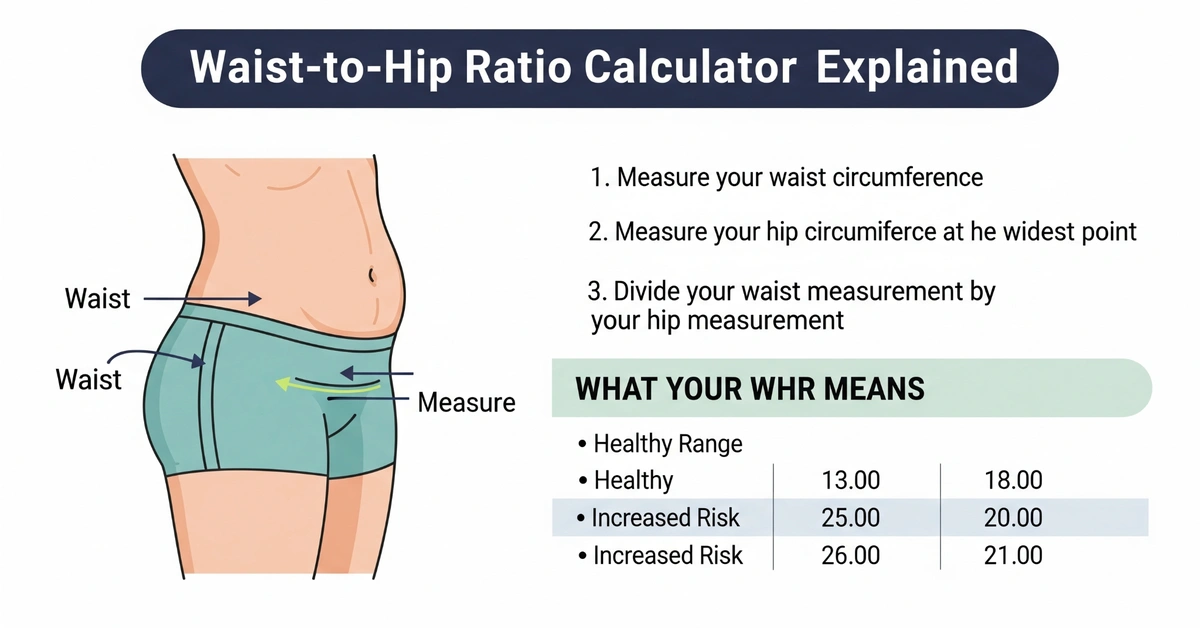Introduction
The Waist-to-Hip Ratio Calculator is a simple yet powerful health tool that measures the proportion between your waist and hip circumference. Doctors and health experts often recommend it because it highlights fat distribution patterns, which can be a better health indicator than weight or Body Mass Index (BMI) alone.
If you’ve ever wondered why two people with the same weight can look very different or have different health risks, the waist-to-hip ratio explains it. This article breaks down what the calculator is, why it matters, how to use it correctly, and what your results really mean.
What Is Waist-to-Hip Ratio?
Waist-to-hip ratio (WHR) is a measurement that compares the size of your waist to the size of your hips. You can calculate it by dividing your waist circumference by your hip circumference.
Formula: WHR = Waist measurement ÷ Hip measurement
Example: If your waist is 30 inches and your hips are 40 inches, your WHR is 0.75.
Unlike BMI, which focuses only on weight and height, WHR shows whether you carry more fat around your middle (apple-shaped body) or your hips and thighs (pear-shaped body). Studies suggest that excess abdominal fat is linked to higher risks of cardiovascular disease, diabetes, and metabolic disorders.
Why Use a Waist-to-Hip Ratio Calculator?
Using a Waist-to-Hip Ratio Calculator saves time and improves accuracy. Instead of manual calculations, the tool instantly provides results along with health interpretations. This helps you understand:
Fat distribution: Central (abdominal) fat is riskier than hip or thigh fat.
Health risks: A higher ratio often indicates greater chances of heart disease, high blood pressure, and diabetes.
Fitness goals: Athletes and health-conscious individuals use WHR to track progress beyond just weight loss.
The World Health Organization (WHO) recommends using WHR as a global measure of obesity and related health concerns.
Waist-to-Hip Ratio Categories
The calculator results fall into different categories depending on gender. According to WHO:
For Women
0.80 or lower: Low health risk
0.81 – 0.85: Moderate health risk
0.86 or higher: High health risk
For Men
0.95 or lower: Low health risk
0.96 – 1.0: Moderate health risk
1.0 or higher: High health risk
These categories show how fat around the waist is more dangerous than fat stored around the hips, especially for men.
Waist-to-Hip Ratio vs. BMI
Many people confuse WHR with BMI. While both measure health risks, they are not the same.
BMI: Focuses on height and weight without showing fat distribution.
WHR: Highlights where fat is stored in the body.
For example, two people with the same BMI could have completely different WHRs. The person with more abdominal fat may face greater health risks even if their BMI is considered “normal.”
For deeper insights, you can explore our BMI Calculator alongside the waist-to-hip ratio calculator to compare results.
How to Measure Waist and Hip Correctly
Accurate measurements are crucial for reliable results. Follow these steps:
Waist measurement: Place a tape measure around the narrowest point of your waist, usually just above your belly button.
Hip measurement: Wrap the tape around the widest part of your hips and buttocks.
Consistency: Stand straight, relax, and avoid holding your breath during measurements.
Once you have these numbers, use the Waist-to-Hip Ratio Calculator to interpret your results.
Benefits of Using the Calculator
Early health warning: Helps spot potential risks even if you have a normal BMI.
Motivation: Seeing changes in WHR can encourage healthier habits.
Tracking progress: Useful for fitness enthusiasts aiming for fat reduction rather than just weight loss.
Holistic health approach: Complements other tools like the Calorie Nutrition Calculator or TDEE Calculator.
Limitations of Waist-to-Hip Ratio
While useful, WHR should not be the only health measure you rely on. Factors such as muscle mass, body type, and genetics also influence results. It’s best to combine WHR with BMI, body fat percentage, and professional medical advice for a full picture of your health.
For scientific evidence, you can read more on World Health Organization’s obesity guidelines (external resource).
Internal Links for More Tools
On our website, you can find other related calculators:
These tools provide additional insights into your health and fitness journey.

Conclusion
The Waist-to-Hip Ratio Calculator is a simple yet powerful way to understand your body’s fat distribution and its impact on health. By taking just two measurements, you can gain meaningful insights that BMI alone cannot provide.
Remember, a low WHR generally indicates lower health risks, while a higher WHR may signal the need to adjust lifestyle habits. Use this calculator alongside other health tools to track progress and make informed choices.
